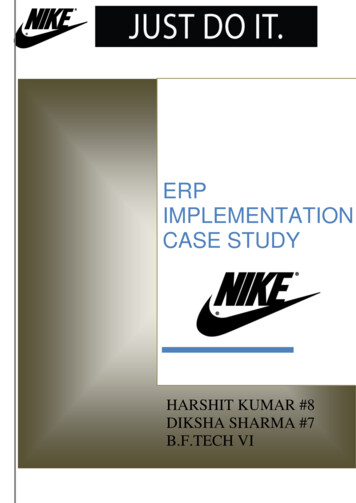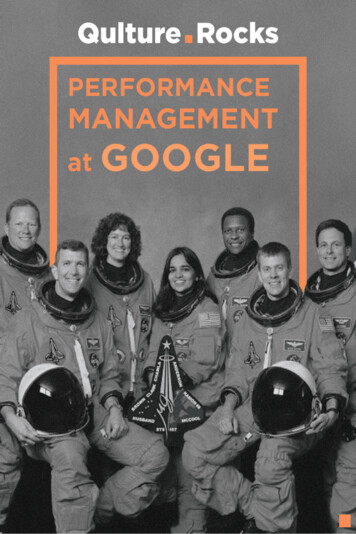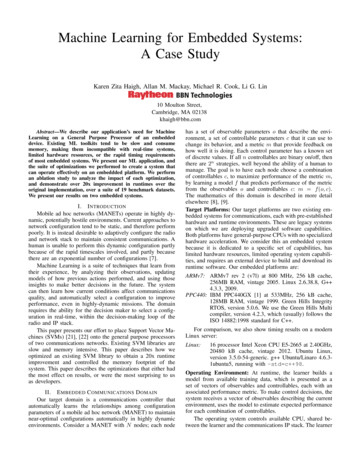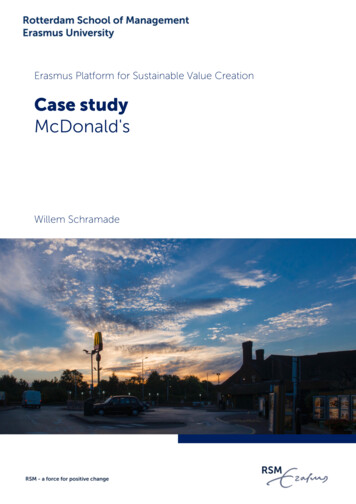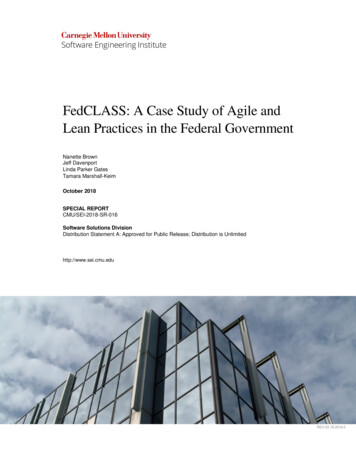
Transcription
FedCLASS: A Case Study of Agile andLean Practices in the Federal GovernmentNanette BrownJeff DavenportLinda Parker GatesTamara Marshall-KeimOctober 2018SPECIAL REPORTCMU/SEI-2018-SR-016Software Solutions DivisionDistribution Statement A: Approved for Public Release; Distribution is Unlimitedhttp://www.sei.cmu.eduREV-03.18.2016.0
Copyright 2018 Carnegie Mellon University. All Rights Reserved.This material is based upon work funded and supported by the Department of Defense under Contract No.FA8702-15-D-0002 with Carnegie Mellon University for the operation of the Software Engineering Institute, afederally funded research and development center.The view, opinions, and/or findings contained in this material are those of the author(s) and should not be construed as an official Government position, policy, or decision, unless designated by other documentation.References herein to any specific commercial product, process, or service by trade name, trade mark, manufacturer, or otherwise, does not necessarily constitute or imply its endorsement, recommendation, or favoringby Carnegie Mellon University or its Software Engineering Institute.NO WARRANTY. THIS CARNEGIE MELLON UNIVERSITY AND SOFTWARE ENGINEERING INSTITUTEMATERIAL IS FURNISHED ON AN "AS-IS" BASIS. CARNEGIE MELLON UNIVERSITY MAKES NOWARRANTIES OF ANY KIND, EITHER EXPRESSED OR IMPLIED, AS TO ANY MATTER INCLUDING, BUTNOT LIMITED TO, WARRANTY OF FITNESS FOR PURPOSE OR MERCHANTABILITY, EXCLUSIVITY, ORRESULTS OBTAINED FROM USE OF THE MATERIAL. CARNEGIE MELLON UNIVERSITY DOES NOTMAKE ANY WARRANTY OF ANY KIND WITH RESPECT TO FREEDOM FROM PATENT, TRADEMARK,OR COPYRIGHT INFRINGEMENT.[DISTRIBUTION STATEMENT A] This material has been approved for public release and unlimited distribution. Please see Copyright notice for non-US Government use and distribution.Internal use:* Permission to reproduce this material and to prepare derivative works from this material for internal use is granted, provided the copyright and “No Warranty” statements are included with all reproductionsand derivative works.External use:* This material may be reproduced in its entirety, without modification, and freely distributed inwritten or electronic form without requesting formal permission. Permission is required for any other externaland/or commercial use. Requests for permission should be directed to the Software Engineering Institute atpermission@sei.cmu.edu.* These restrictions do not apply to U.S. government entities.Carnegie Mellon is registered in the U.S. Patent and Trademark Office by Carnegie Mellon University.DM18-0578CMU/SEI-2018-SR-016SOFTWARE ENGINEERING INSTITUTE CARNEGIE MELLON UNIVERSITYDistribution Statement A: Approved for Public Release; Distribution is Unlimited
Table of ContentsAcknowledgmentsvExecutive SummaryviAbstractx1Introduction1.1 Purpose and Overview of This Case Study1.2 Organizations Involved in the Case Study1.2.1 The Software Engineering Institute1.2.2 Department Omega1.2.3 Program Alpha1.2.4 Service Providers1.2.5 The Development Team1.2.6 The Deployment Team1.2.7 Interrelationships11333334442Rationale for Change2.1 The Inadequacy of the Existing System2.2 Personnel Shortages2.3 Government Information Technology Reforms2.4 The FedCLASS Project2.4.1 Inadequacy of the Current System2.4.2 Personnel Shortages2.4.3 Government Information Technology Reforms555667773Project Initiation3.1 Key Events in the Project Initiation Process3.1.1 Determining Software Requirements3.1.2 Assessing the Architecture3.1.3 Aligning the Development Effort with the Organization’s Strategic Plan3.1.4 Attempting to Reuse the Old System3.1.5 Planning for the Future3.1.6 Changing the Development Approach3.2 Adopting New Development Practices8889991010114Establishing the Team4.1 Contracting for Technical Expertise4.2 Creating the Development Team4.2.1 Team Structure and Roles4.2.2 Project Sponsor4.2.3 Product Owner4.2.4 Project Manager4.2.5 Federal and State Agency Stakeholders4.2.6 Team Members4.3 Training the Development Team121213141415151515165Project Implementation5.1 Starting with RUP5.1.1 Release 1: Inception Phase5.1.2 Release 1: Elaboration Phase18181919CMU/SEI-2018-SR-016SOFTWARE ENGINEERING INSTITUTE CARNEGIE MELLON UNIVERSITYDistribution Statement A: Approved for Public Release; Distribution is Unlimitedi
5.25.35.45.55.65.75.8Moving to Lean and Kanban5.2.1 Release 2: Developing Core Functionality5.2.2 Release 3: Developing Additional Core Functionality5.2.3 Release 4: Addressing Non-Core FunctionalityDeployment5.3.1 Experiences with Converting the Old Databases5.3.2 Integrating with the Data CenterEstimating System CompletionChanging Definitions of SuccessPreparing for DeploymentAutomated Delivery Pipeline and Continuous ject Analysis6.1 Analysis of Agile and Lean Adoption6.1.1 Requirements and Test6.1.2 Enhancing Collaboration6.1.3 The Contracting Environment6.1.4 Improving Estimation6.1.5 Metrics and Continuous Improvement6.2 Analysis of Technical Approaches6.2.1 Cloud Development6.2.2 Automation6.2.3 Layered Architecture6.2.4 Open Source Frameworks6.2.5 Data Conversion6.3 Analysis of Leadership6.3.1 Cultural Change6.3.2 The Agile Interface6.3.3 Risk ry40Appendix AProject Stakeholders42Appendix BProject Timeline45Appendix CDevelopment Tools46Appendix DTraining for the Agile Development Team48Appendix EAcronyms and Glossary49Appendix FKey Project Documents53ReferencesCMU/SEI-2018-SR-016SOFTWARE ENGINEERING INSTITUTE CARNEGIE MELLON UNIVERSITYDistribution Statement A: Approved for Public Release; Distribution is Unlimited54ii
List of FiguresFigure 1:A Broad New Pilot2Figure 2:Interrelationships Among Organizations Involved in Developing the New System4Figure 3:Key Project Initiation Events8Figure 4:Hierarchy of the Development Team13Figure 5:Team Role Interfaces of the Development Effort for the New System14Figure 6:Release Plan Diagram20Figure 7:Release 1: Establishing a Candidate Architecture20Figure 8:Release 2: Core Functions23Figure 9:Release 3: Core Functions24Figure 10:Release 4: Non-Core Functions25Figure 11:Moving to Go-Live Deployment26CMU/SEI-2018-SR-016SOFTWARE ENGINEERING INSTITUTE CARNEGIE MELLON UNIVERSITYDistribution Statement A: Approved for Public Release; Distribution is Unlimitediii
List of TablesTable 1:Agile and Lean Practices Used by the Development Team22Table 2:Development Tools Used in the FedCLASS Project46Table 3:Identified Training Events for the FedCLASS Project48CMU/SEI-2018-SR-016SOFTWARE ENGINEERING INSTITUTE CARNEGIE MELLON UNIVERSITYDistribution Statement A: Approved for Public Release; Distribution is Unlimitediv
AcknowledgmentsThe authors would like to thank the individuals who provided access to their federal developmentproject. Department leadership gave the Carnegie Mellon University Software Engineering Institute broad access to all project documentation and the daily operations of the development team.Without this open and broad access, it would not have been possible to create this case study. Theauthors also wish to thank the members of the development team who talked with us openly aboutthe project and allowed us to observe daily standup sessions and whole days of team activities.Finally, the authors would like to express our appreciation for all those who contributed to or reviewed this case study and its predecessor. We extend our sincerest thanks to Eric Ferguson, KenNidiffer, Mary Ann Lapham, Annie Drazba, Kurt Hess, Pennie Walters, Gerald Miller, and ToddLoizes.CMU/SEI-2018-SR-016SOFTWARE ENGINEERING INSTITUTE CARNEGIE MELLON UNIVERSITYDistribution Statement A: Approved for Public Release; Distribution is Unlimitedv
Executive SummaryPurpose of This Case StudyThis anonymized case study tells the story of an actual development project for a new softwaresystem undertaken by a key program within an executive department of the U.S. federal government. The purpose of the project was to develop a new version of the software used by this department in the performance of its mission, and to do it using iterative, Agile, and Leandevelopment methods, an approach recently recommended by the federal government at the timeof this study. This case study documents the history and approaches used during the developmentof the new system and illustrates the successes and challenges of applying iterative, Agile, andLean development methods in an organization that previously used more traditional developmentmethods. The purpose of this case study is to inform other organizations about lessons learnedfrom this project, both positive and negative, so that they may benefit from the department’s experience in piloting iterative, Agile, and Lean practices. This case study was constructed from extensive access to the project and discussions with team members of the project, other staff in theexecutive department, and development and testing contractors; documentation reviews; observations of daily team activities; and analysis of work products from the project.The Business Need for a New Software SystemAt the time of the project, the executive department was developing strategic plans to expand thecontext of its operations. However, department personnel recognized that the software they wereusing, referred to in this report as LEGACY, had reached capacity during peak processing timesand could not easily accommodate changes in its functionality.A 2010 Federal Chief Information Officer (CIO) report had called for reform of federal information technology (IT) management, outlining 25 points that federal agencies should address inorder to produce greater returns on the government’s investment in IT. The department recognized that three points of the plan were especially relevant to the department’s views on modernization [Kundra 2010]: Point 3: Shift to a “cloud first” policy Point 6: Develop a strategy for shared services Point 15: Issue contracting guidance and templates to support modular developmentRecognizing LEGACY’s limitations and motivated by the Federal CIO’s call to reform government IT practices, the executive department decided to replace the old system with a to-be-engineered system, referred to in this report as Federal Cloud-based Lean and Agile Shared Services,or FedCLASS, which would support these new considerations.A New Approach to Software DevelopmentIn the past, the department used traditional waterfall approaches to software development. ForFedCLASS, department executives decided to use a different approach that better aligned withmodern software development practices, including iterative development, Agile and Lean practices, and cloud-based technologies.CMU/SEI-2018-SR-016SOFTWARE ENGINEERING INSTITUTE CARNEGIE MELLON UNIVERSITYDistribution Statement A: Approved for Public Release; Distribution is Unlimitedvi
In particular, the project decided to manage the project using the iterative lifecycle and risk-focused techniques of the RationalUnified Process (RUP) [RSC 1998] incorporate Agile practices and principles, including integrating business owners into the development process with direct accountability formeeting delivery goals having all FedCLASS team members be dedicated 100% to the FedCLASS Project allowing the development team to be self-organizinguse current technologies and tools, including writing FedCLASS in Java developing in the cloud employing automation tools that support Agile and Lean development practices (e.g., automated test, continuous integration, and automated build)Because of the sweeping nature of the changes being made, the department decided to hire consultants and coaches to help implement and institutionalize these new approaches, tools, technologies, and methods.Implementation of Agile and Lean Principles of DevelopmentAfter the project kickoff, the executive department began to implement Agile principles. For thefirst three months, all members of the FedCLASS Project were physically co-located. After that,virtual-presence software connected team members all day via video teleconferencing. All teammembers maintained a constant virtual presence, appearing in a “Hollywood Squares” type of visual projection that enabled them to be constantly accessible and aware of the needs of other teammembers. This allowed the team to work as though they were co-located no matter where theywere.The FedCLASS team did not function according to the traditional siloed structure but insteadworked together as a cross-functional Agile team. All team members were fully dedicated to theproject, were required to have varied skill sets or be open to learning, and performed their workwith complete transparency. The FedCLASS team was responsible for completing all aspects ofeach development task (i.e., user stories) through coding, test, integration, and build. There wasno handoff to a separate testing organization.Individuals in three key positions—the project sponsor, product owner, and project manager—served as critical change agents for both trying new IT technology and methods and establishingnew relationships within the organizations involved. The team included a few outside consultantswho served as coaches for using the new development practices and introducing new developmenttechnologies and tools.The concept of fully dedicated team member assignments was a dramatic change for both the executive department and for the testing and development contractors, as it represented a significantinnovation and discontinuity in their historic relationship.CMU/SEI-2018-SR-016SOFTWARE ENGINEERING INSTITUTE CARNEGIE MELLON UNIVERSITYDistribution Statement A: Approved for Public Release; Distribution is Unlimitedvii
Integration with the Data CenterThe cross-functional FedCLASS Agile team integrated the business owners and contractors aswell as functional development and test. However, the operations team responsible for managingthe executive department’s data center and deploying FedCLASS remained aligned with the operations function rather than aligned with the development team’s processes. Initially, the deployment team’s personnel were unable to adapt to the Agile practices used by the FedCLASSdevelopment team. However, strong leadership support from the department helped the two teamsfigure out ways to bridge the gap between the development team’s Agile methods and the datacenter’s traditional methods.For example, the development team treated the integration of their project into the data center as aparallel project rather than an inherent and integrated aspect of their Agile and Lean developmentprocess, which allowed the deployment team to retain its traditional approaches. The developmentteam developed a more structured listing of necessary work, allowing the deployment team to better understand the system requirements.The deployment team also instituted some new approaches to support the deployment ofFedCLASS. Previously, they established and maintained operational environments using manual,often labor-intensive, processes. During the FedCLASS Project’s development phase, however,the development team demonstrated the value and benefit of using the systems integration framework Chef to build the FedCLASS operational infrastructure more automatically. The deploymentteam adopted these techniques from the development team, which reduced building theFedCLASS operational environment from a months-long effort to an hours-long effort.Finally, the executive department’s leadership met regularly with the deployment team’s leadership to ensure effective communication and progress, identify barriers, and assign actions for follow-up.Key FindingsThis executive department chose to follow a new direction in creating FedCLASS, making a fundamental break with previous practices and technologies. To accomplish its goal, the departmentexplored these broad areas of innovation: A new role for management: The business owner had extensive experience with LEGACYand was willing to take direct responsibility for achieving the primary business goal of theFedCLASS Project. In the past, that responsibility rested with the contractor and was mediated via a formal contract. New technology: Cloud-based development, a new programming language, new commercialproducts, and new development environments and tools were introduced to build a foundationfor future growth. These new technologies and methodologies were not part of the existingskills in the department. A new development team concept: The department embraced Agile development team concepts, such as having dedicated team members who were self-organized and operating in avirtual team room. New software methodologies: The project piloted and experimented with using an iterativedevelopment lifecycle (RUP), Agile team management (Scrum), and Lean flow (Kanban) asCMU/SEI-2018-SR-016SOFTWARE ENGINEERING INSTITUTE CARNEGIE MELLON UNIVERSITYDistribution Statement A: Approved for Public Release; Distribution is Unlimitedviii
well as Agile technical practices derived from XP, including automated test-driven development and pair programming. The department used external coaches to provide newknowledge rapidly for the innovative pilot.What started as an innovative pilot of new technology and approaches became a broad new transformation developmental effort that effected changes across the executive department. Key enabling factors for the transformation included a business owner who had professional IT skills and operational experience in the business area a program manager who had experience with new technology an environment of government-wide IT reform and a push toward new technology and methods a senior leader who was willing to try something differentMany factors and influences came together at the start of the FedCLASS Project that helped itsucceed. They supported and reinforced each other, making it possible for the project to startdown an uncharted path and become a model for change within a department of the federal government.CMU/SEI-2018-SR-016SOFTWARE ENGINEERING INSTITUTE CARNEGIE MELLON UNIVERSITYDistribution Statement A: Approved for Public Release; Distribution is Unlimitedix
AbstractThis case study tells the story of the development of a critical IT system within an executive department of the U.S. federal government, using iterative, Agile, and Lean development methodsand cloud-based technologies. This study reports the successes and challenges of using this newdevelopment approach in a government software development environment so that other government entities can benefit from the experiences of this project. The study is based on conversationswith team members, observations of team activities, and examination of work products, documentation, and program guidance. The report describes the organizations responsible for creating thesoftware solution, establishing the development process, and structuring acquisition activities. Itthen details the product development process in chronological order and describes the development approaches and technologies. It also puts events into the context of external environmentalinfluences to present a development effort as it confronts real-world challenges. The final sectiondescribes insights gleaned during the research of this case study and includes analysis of the organization’s experiences with Agile and Lean adoption, technical approaches, and project leadership. These insights may benefit future Agile projects in the federal government and the softwareengineering community as a whole.CMU/SEI-2018-SR-016SOFTWARE ENGINEERING INSTITUTE CARNEGIE MELLON UNIVERSITYDistribution Statement A: Approved for Public Release; Distribution is Unlimitedx
1 IntroductionThis case study tells the story of a software-development initiative undertaken by a key programwithin an executive department of the U
1.2.1 The Software Engineering Institute 3 1.2.2 Department Omega 3 1.2.3 Program Alpha 3 1.2.4 Service Providers 3 1.2.5 The Development Team 4 1.2.6 The Deployment Team 4 1.2.7 Interrelationships 4 2 Rationale f






